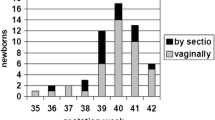Abstract
A surveillance program was implemented to investigate the molecular epidemiology of Enterobacter cloacae in neonatal units. This program ran for 2 years and involved screening for E. cloacae intestinal colonization of all infants at admission and weekly thereafter. In addition, mothers whose children were admitted to neonatal units were also screened. Pulsed-field gel electrophoresis analysis was used to establish genetic relationships between strains and to identify mother-to-child transmission. During the survey period, 166 (22.6%) of the 735 included children had E. cloacae intestinal colonization, and 29 (3.9%) patients gave clinical samples positive for E. cloacae. Genotyping revealed 90 different pulsotypes in the 199 clinical and screening isolates from neonates, including three major epidemic clones. Mother-to-child transmission of E. cloacae was directly responsible for 8.8% of intestinal colonization of the neonates. This surveillance program reveals a major contribution of patient-to-patient transmission and the rarity of mother-to-child transmission in the spread of E. cloacae in neonates. This highlights the importance of good compliance with infection control procedures by health-care workers.



Similar content being viewed by others
References
Gaston MA (1988) Enterobacter: an emerging nosocomial pathogen. J Hosp Infect 11:197–208
Sanders Jr WE, Sanders CC (1997) Enterobacter spp: pathogens poised to flourish at the turn of the century. Clin Microbiol Rev 10:220–241
Bingen E, Denamur E, Lambert-Zechovsky N, Brahimi N, El lakany M, Elion J (1992) Rapid genotyping shows the absence of cross-contamination in Enterobacter cloacae nosocomial infection. J Hosp Infect 21:95–101
Lambert-Zechovsky N, Bingen E, Denamur E et al (1992) Molecular analysis provides evidence for the endogenous origin of bacteremia and meningitis due to Enterobacter cloacae in an infant. Clin Infect Dis 15:30–32
Wang CC, Chu ML, Ho LJ, Hwang RC (1991) Analysis of plasmid pattern in pediatric intensive care unit outbreaks of nosocomial infection due to Enterobacter cloacae. J Hosp Infect 19:33–40
Tresoldi AT, Padoveze MC, Trabasso P et al (2000) Enterobacter cloacae sepsis outbreak in a newborn unit caused by contaminated total parenteral nutrition solution. Am J Infect Control 28:258–261
Harbarth S, Sudre P, Dharan S et al (1999) Outbreak of Enterobacter cloacae related to understaffing, overcrowding, and poor hygiene practices. Infect Control Hosp Epidemiol 20:598–603
Van den Berg RWA, Claahsen HL, Niessen M, Muytjens HL, Liem K, Voss A (1999) Enterobacter cloacae in the NICU related to disinfected thermometers. J Hosp Infect 45:29–34
Fernandez-Baca V, Ballesteros F, Hervas JA et al (2001) Molecular epidemiological typing of Enterobacter cloacae isolates from a neonatal intensive care unit: 3-year prospective study. J Hosp Infect 49:173–182
Falkiner FR (1992) Enterobacter in hospital. J Hosp Infect 20:137–140
Talon D, Menget A, Thouverez M et al (2004) Emergence of Enterobacter cloacae as a common pathogen in neonatal units: pulsed-field gel electrophoresis analysis. J Hosp Infect 57:119–125
Members of SFM Antibiogram Committee (2003) Comité de l’antibiogramme de la Société Française de Microbiologie. Report 2003. Int J Antimicrob Agents 21:364–391
Bertrand X, Hocquet D, Boisson K, Siebor C, Plésiat P, Talon D (2003) Molecular epidemiology of Enterobacteriaceae producing extended-spectrum b-lactamase in a French university-affiliated hospital. Int J Antimicrob Agents 22:128–133
Tenover FC, Arbeit RD, Goering RV et al (1995) Interpreting chromosomal DNA restriction patterns produced by pulsed-field gel electrophoresis:criteria for bacterial strain typing. J Clin Microbiol 33:2233–2239
Goldmann DA, Leclair J, Macone A (1978) Bacterial colonization of neonates admitted to an intensive care environment. J Pediatr 93:288–293
Almuneef MA, Baltimore RS, Farrel PA, Reagan-Ciricione P, Dembry LM (2001) Molecular typing demonstrating transmission of gram-negative rods in a neonatal intensive care unit in the absence of a recognized epidemic. Clin Infect Dis 32:220–227
Toltzis P, Dul MJ, Hohen C et al (2001) Molecular epidemiology of antibiotic-resistant gram-negative bacilli in a neonatal intensive care unit during a non-outbreak period. Pediatrics 108:1143–1148
Verweij PE, Van Belkum A, Melchers WJ, Voss A, Hoogkamp-Korstanje JA, Meis JF (1995) Interrepeat fingerprinting of third-generation cephalosporin-resistant Enterobacter cloacae isolated during an outbreak in a neonatal intensive care unit. Infect Control Hosp Epidemiol 16:25–29
Harmsen HJ, Wildeboer-Veloo AC, Raangs GC et al (2000) Analysis of intestinal flora development in breast-fed and formula-fed infants by using molecular identification and detection methods. J Pediatr Gastroenterol Nutr 30:61–67
Adlerberth I, Carlsson B, de Man P et al (1991) Intestinal colonization with Enterobacteriaceae in Pakistani and Swedish hospital-delivered infants. Acta Paediatr Scand 80:602–610
Wold AE, Adlerberth I (2000) Breast feeding and the intestinal microflora of the infant-implications for protection against infectious diseases. Adv Exp Med Biol 478:77–93
White RD, Townsend TR, Stephens MA, Moxon ER (1981) Are surveillance of resistance enteric bacilli and antimicrobial usage among neonates in a newborn intensive care unit useful. Pediatrics 68:1–4
Author information
Authors and Affiliations
Corresponding author
Rights and permissions
About this article
Cite this article
Gbaguidi-Haore, H., Talon, D., Thouverez, M. et al. Molecular epidemiology of Enterobacter cloacae in a neonatal department: a 2-year surveillance study. Eur J Clin Microbiol Infect Dis 27, 643–648 (2008). https://doi.org/10.1007/s10096-008-0484-8
Received:
Accepted:
Published:
Issue Date:
DOI: https://doi.org/10.1007/s10096-008-0484-8




